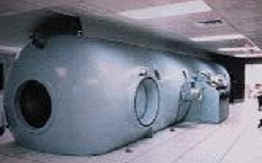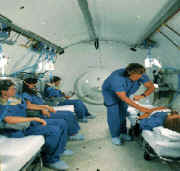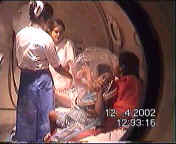It has a small double door air-lock and also a submarine type double door entry to facilitate entry and exit even while HBOT is going on.

The chamber we use can accommodate up to 8 sitting patients at a time.



PLACE OF HYPERBARIC OXYGEN THERAPY TODAY |
| Dr.
Tarun Sahni, H.O.D. of HBOT, Apollo Hospital, Delhi |
Increased pressure reduces bubble size in conditions such as Air Embolism and Decompression Sickness.
HBO is used as an adjunct treatment of soft tissue infections with tissue necrosis due to mixed aerobic and anaerobic organisms. These conditions ' include necrotising cellulitis, progressive dermal gangrene, anaerobic streptococcal myostitis etc. The elevation of oxygen tension by HBO therapy has powerful effects on wound dynamics, by both enhancing leukocyte, bactericidal activity and promoting the fibroblast collagen support needed for neo-vascularisation. All such wounds should be referred to a Hyperbaric Unit in addition to the conventional treatment
- Reduction in fluids
- Less conversion to full thickness injury
- Preservation of marginally viable tissue
- Improved microcirculation
- Faster epithelization
- Less inflammatory response have been reported with HBO therapy
- Significant reduction in hospital stay is also noted.
The basic physiology of this process is a progressive obliterative endarteritis with resultant hypoxic and tissues ischemia. The cure rate for radionecrosis reaches 94% in patients treated with HBO.
Hyperbaric oxygen is effective in promoting capillary proliferation and granulation to prepare a surgical site. This preparation is essential for patients who require grafts or flaps to cover areas where compromised microcirculation or hypoxia contributes to questionable viability of the transplanted tissue.
HBO provides periodic elevation of bone and tissue oxygen tensions from hypoxic of normal or hyperoxic levels. This promotes angiogenesis, increased leukocyte killing, aminoglycoside transport across bacterial cell walls and osteoclast activity in removing necrotic bone.
Intermittent use of HBO therapy will supply enough oxygen to support the basic metabolic needs in cases where patient has lost sufficient red cells mass to compromise respiratory requirements and is not willing for transfusion (Jehova's Witness) or has some rare blood groups.
HBO is recommended in intra-cranial Abscesses, where surgery is contraindicated. This will be beneficial because of anaerobic bacterial flora, reduction of edema, enhancement of host defense mechanism.
HBO increases oxygen supply to ischemic neurons, reduces edemas and reverses the reduced flexibility of erythrocytes.
Cochlear activity is sensitive to and can be improved by HBO therapy.
Use of HBO along with other measures has found to be effective in retinal arterial thrombosis and reduces edema in retinal venous thrombosis.
AGE could occur as a result of surgical procedures in a hospital setting, due to over expansion in a patient on respirator, or penetrating injuries of the chest. HBO is the primary treatment for AGE from any cause. DCS is caused by nitrogen bubble formation in the vascular system. HBO therapy should begin during the acute episode and continue till symptoms clear.
Use of HBO along with other measures has been found to be partially effective in improving some signs and symptoms in very young children with cerebral palsy and autism, when there still is some viable injured neural tissues left around the zone of brain damage. However, these indications are still not officially approved, and are the subject of worldwide trials.
The Hyperbaric Oxygen Treatment Center is located on the Ground-Floor of the main building. The treatment area is a large metallic room large enough to allow two patients to lie down comfortably, or for up to 8 patients to be treated in the sitting position. A nurse / paramedic especially trained in Hyperbaric Therapy will be with the patients inside the treatment chamber. Doctors with internationally recognized expertise in Hyperbaric Medicine supervise the treatment. Highest international safety standards are applied in this treatment facility.
| The Apollo Center resembles this chamber at another center
abroad =>
It has a small double door air-lock and also a submarine type double door entry to facilitate entry and exit even while HBOT is going on. |
 |
This is an inside view of a typical Multiplace chamber of
the type we use =>
The chamber we use can accommodate up to 8 sitting patients at a time. |
 |
 |
<== This is the main console of the Multiplace HBOT Chamber at Apollo Hospital, New Delhi, showing Dr. T. Sahni (right) supervising the therapy with his Assistant. |  |
<== This is the inside view of the Multiplace HBOT Chamber at Apollo Hospital, New Delhi, with the type of HBOT mask and tubing worn by two of our children with CP along with their mothers and a trained nurse in constant supervision inside the chamber throughout the procedure. |
The Apollo Chambner resembles this chamber at another center
Trained staff will assist in making the patient comfortable (sitting / lying) in the treatment chamber. The pressure in the chamber will be increased, in about 10 minutes. The Nurse should be notified at the first sign of discomfort in the ears or sinuses so that they can help relieve the sensation. The Technician / Doctor will adjust the rate of compression to reduce the fullness in your ears. Ears will clear naturally on decompression. The air in the chamber will get warm during compression. When the treatment pressure is attained, the warm air will be vented out and the chamber ventilated with fresh air for the whole time of the treatment. After the treatment the chamber will be decompressed, which will take 10-15 minutes.
Each single treatment session lasts about 2 hours. This includes 60-90 minutes in the chamber in addition to preparation and observation time. The number of treatments required will depend on the nature of the problem. Patients are generally treated once a day, but may require therapy twice a day.
The treatment does not need admission. The patient may be referred only for HBO therapy at this center, while the entire treatment otherwise could continue as desired by him at a center of his choice or as an outpatient.
Some tests may be needed to make sure that the patient is comfortable during the treatment. These may include examination of ears for ability to equalize pressure, check-up of lungs, some blood tests, eye examination and other tests depending on your general state of health.
Acknowledgement: Dr. Tarun Sahni, Head of Dept. of Hyberbaric Medicine, Apollo Hospital, Sarita Vihar, New Delhi
EXPERIENCE AT UDAAN: Four to six months or
more after starting HBOT.
The experience at UDAAN, with CP children given HBOT suggests that:
Hence, we observed a rapid (2 to 4 months) improvement in Cognitive functions, understanding, cooperative spirit, stamina, obeying of commands, following of commands, and willingness to do the therapeutic maneuvers told. The child spontaneously wants to do more and more. This results in a gradually improving physical development that seems to peak during month 4 to 6 AFTER completion of 40 sessions of HBOT. Thereafter, there is still a steady Neurodevelopmental growth, which we have observed even two years post-HBOT, without any going back as commonly seen with Nerve Block.
Some of our earliest HBOT Group children (2001) are supported walkers or independent walkers now (in 2004). If their parents could afford, we would suggest 20 sessions at a time as follow up at intervals of 6 months, for at least 3 to 4 more such rounds, as long as their Neuro-development rate is greater than in Non-HBOT children. UDAAN has been in existence since 1992, and none of the similar moderate to severe CP children in Non-HBOT group have developed the degree and quality of independent walking that the HBOT children have acquired in such a short period.
| Click here to go to top |